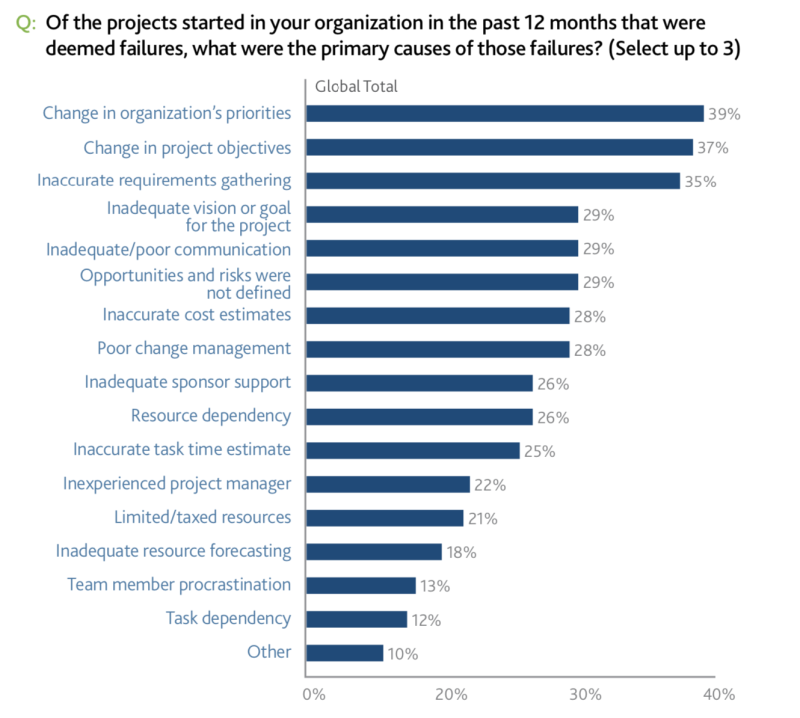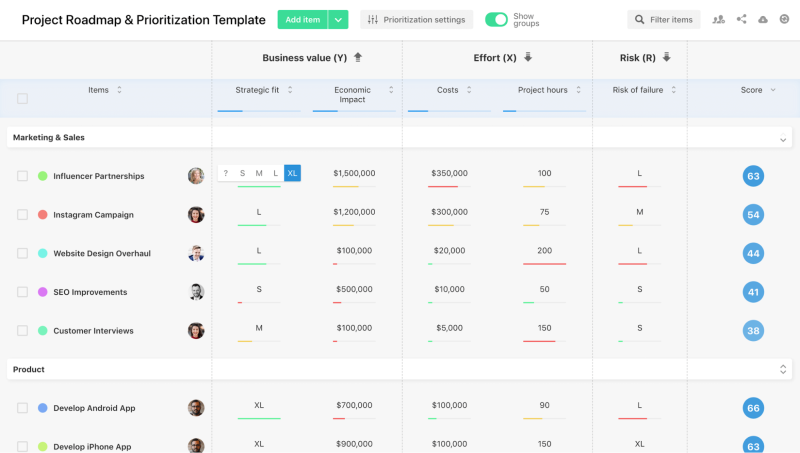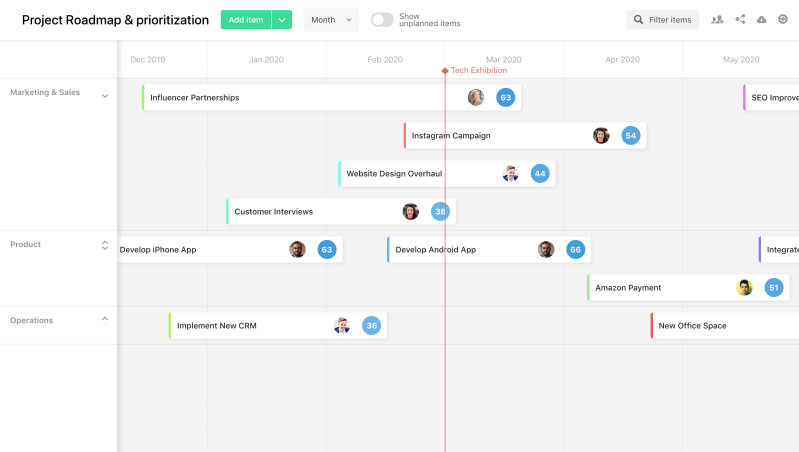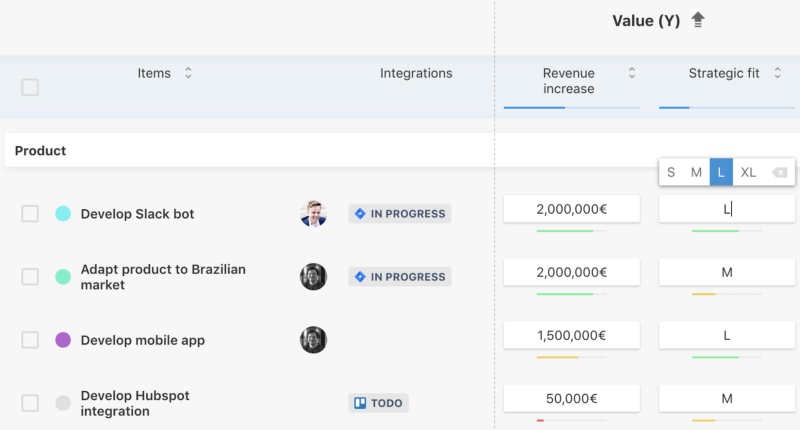Easy To Use Project Plan Templates for Busy Product Managers

In the classic 1980s television series "The A-Team," the team leader Hannibal would proudly say a catchphrase at the end of another successful mission.
“I love it when a plan comes together.”
Sadly, the television show focuses more on shooting and entertaining ingenuity than the planning process.
We'd have loved to see the team sit down for a project planning workshop and play some priority poker but that's just not as entertaining as a car chase.
I love it when we use project planning best practices and achieve the objectives of the project together.
As busy product managers, we know the truth — a solid plan is essential for a product to magically 'come together.'
Whether you’re tasked with prioritizing items in the product backlog or getting an innovation market-ready, a project plan will help you deliver on time, on budget, and the scope. 37.9% of product managers say their backlog is a jumble.
In this article, we'll go into detail about what The A-Team left out: how to write a useful, realistic, and visually appealing project plan.
Even better, we’ll show you how to write a project plan using a free template.
What is a project plan?
A project plan is a strategic document that shows the steps required to take a project from its current state (A) to a future state (B). It is structured around a timeline and shows all the major tasks required for the project to be completed successfully.
At a minimum, a project plan should be able to answer four questions at any point during the project:
What? What work must be completed? What are the key deliverables from the project?
Why? What is the key goal of the project, and why are we doing it?
Who? Who is responsible for completing the tasks within the project?
When? How much time do we have to complete the project? Are there any key milestones to be met along the way?
Why is a project plan a useful tool for product managers?
Recently, it feels like there’s new and added pressure to move fast and jump into projects without significant planning. As a busy product manager, we're sure you've felt this pressure too.
However, according to the Project Management Institute, four of the top seven reasons for project failure could have been avoided entirely with effective project planning:
Inaccurate requirements - 35%
Inadequate vision or goals - 29%
Undefined risks - 29%
Inaccurate cost estimates - 28%

With a properly constructed project plan, you'll gain a strategic view of the project and unlock a wide range of benefits:
Benefit 1: Clear goals & objectives
Before you start working on the smaller details of your project plan, you need to understand what the project is and why you are doing it.
The best way to discover this is to write an objective for your project. For example, let's say we're building a new website for airfocus, intending to tell more people how great our software is.
This is a good starting point — it outlines what we're doing and why we're doing it.
But spend a little longer in the planning process and speak to key stakeholders in your organization to add extra detail and make the objective more measurable. It's well worth spending ample time here, as 'inadequate vision of goals' leads to 37% of project failures.
For our new website project, a clear objective could be:
Launch a new airfocus website by the end of Q2, with the goal of increasing visitors by 25%.
This is a SMART objective: it’s specific, measurable, actionable, realistic, and time-specific.
Underneath this, we could add further objectives and goals to help measure our progress towards stakeholder requirements.

There are two key benefits to having a clear project objective. One is that the success of the project can be easily measured. The second is that everyone involved knows how their work contributes to achieving the overall goal.
Benefit 2: Preventing scope creep
If your project suffers from changing requirements, additional deliverables being added, or unwanted requests from stakeholders, you have scope creep.
An effective project plan helps prevent scope creep in three vital ways:
The project requirements are clearly documented: By talking to your stakeholders at the start of the project, you can fully understand their needs and manage conflicts between them. This helps stakeholders understand the compromises required to complete the project and discourages large changes later.
Any change is then controlled: With a project plan, you control changes to the project. If it isn't added to the plan, the work doesn't get done, and the scope doesn't change. If you do make changes, be sure to revisit the project plan and find a low-impact way to make the change.
All work is scheduled and agreed upon: A project plan provides a clear view of what everyone in the project is doing. If stakeholders cannot understand how resources are being used, they might decide to reassign them elsewhere or give them tasks outside your project scope.
Benefit 3: Greater control over resource planning
Returning to our Project Management Institute statistics, we know that poor resource allocation is one of the most frequent causes of project failure.
By creating a detailed project plan, you can identify what you'll need before starting the project and secure stakeholder support for getting those resources.

The simplest thing you'll need is physical equipment, such as technology, tools, or materials.
The most complicated resource is people. You'll need employees, contractors, freelancers, or external help to complete the project.
With a comprehensive plan, you'll know how much to spend on equipment, what key skills you need and how you'll allocate these people to complete the key tasks in the project.
Importantly, you can avoid overloading people with too much work and build a happier team.
Without a comprehensive plan, you risk constantly asking your manager for further resources and extra budget. More often than not, internal budget approval takes time to come through, which ends up delaying your project.
Benefit 4: Clearer progress tracking
It is impossible to track progress without knowing where you are headed and what you are doing.
A good project plan enables you to see what has been done and what must be done next. This enables you to report progress to your stakeholders, keeping them informed throughout the project.

By knowing exactly what is happening, you'll also be able to see when dependencies occur within your project. For example, task C cannot be completed until task A is done.
With an effective project plan, you can avoid blockers by assigning more resources to task A when it falls behind schedule.
What is a project plan template? And why do product managers need one?
A free project plan template gives you all the benefits of a project plan, in a ready-made format. Simple download the template, input your project-specific detail, and get started.
But why do you need one? Can't you just open Excel or Word and go from there?
In our view, a project plan template is a smarter way to work because:
It saves time: Once you've found a template that works for, you can roll it out across every project, avoiding the need to create a new document from scratch each time. Just add the project details and get started quickly.
The template is standardized: As the project plan looks the same each time, it's easy for your team to understand. No need to explain how the document is formatted.
A template is always adaptable: Even a simple project plan template can adapt to suit your latest project. For example, the milestones can easily be changed and any calculations used for prioritization updated.
It provides a helpful framework: Even the best product manager in the world forgets things from time-to-time. A good template works like a checklist — you'll be sure to fill in all the blanks and fully understand the project before starting.
How do you create a free project plan template?
There are four key templates you’ll need as part of a complete project planning template package:
Documentation template: For your research, proposals, and your general plan of action
Project plan template: So you can see all the tasks on a clean project plan and keep it updated easily
Prioritization template: So you know what the most important tasks are in your project
Results template: This makes reporting easier and more consistent
Let’s go through each of these in turn...
Documentation template
Clear and effective documentation is essential for getting stakeholder buy-in and sharing key project information.

When you are creating a documentation template, be sure to include:
Your company or client logo on an attractive cover page
Common page templates separated into sections. For example, a project description with objectives and scope, a simple timeframe summary that clearly shows the stages of the project, a table of your resource and budget requirements, and a summary section for busy stakeholders to read quickly
Header and footers that help the read navigation of your document
You can find a wide range of document templates on Template.net. These templates include a 'quick entry' feature, which lets you enter variables once (like the project name) and see it instantly duplicated throughout the document.
When you are ready to turn this document into a structured plan of action, use airfocus. We have a brilliant release plan template which can be used to show stakeholders upcoming work items.
Project plan template
As ex-product managers ourselves, we’ve had to work with badly printed Excel documents stuck to the wall as project plans. Instead of using Excel, start with a template in a dedicated project management software tool like airfocus.
Our Project Roadmap and Prioritization Template is a great starting point. You start with a visually attractive roadmap, there’s no setup needed. Just tweak the timescales and prioritization criteria to suit your needs, then start adding your tasks.

When you are done, this template can easily be shared via a simple link. This link is always up-to-date, so no more printing the latest version!

To get started with an airfocus project plan template of your own, watch our helpful video:
Select a template from our gallery or start with a custom workspace.
Configure your prioritization template yourself, or pick from our range of defaults
Start constructing your project plan, adding your items as needed
Use the built-in sharing functionality to send it to stakeholders instantly — no formatting required
Prioritization template
Roadmaps are an excellent tool to visualize your high-level strategy. But, even with the best template and planning in the world, no team has unlimited resources.
To decide what makes it into your project plan, you need to prioritize.
This will make sure you are using your limited resources on tasks with the highest impact.
There are many approaches on how to prioritize a roadmap, but the simplest and most time effective is a "prioritization matrix" or "weighted scoring model". This is a well-tested framework which will help to identify risk and ensure the success of your project.

We include ready-to-use prioritization frameworks within all of our templates, so you don’t need to invent your own. These frameworks are used by thousands of companies and decision-makers like Nike, Shell, and The Washington Post. Check them out here.
Results template
By now, your project should be up-and-running. This means you'll need to share status updates with your stakeholders when you hit key milestones or come up against obstacles.
Creating a results template will help you to track your progress, whilst being able to share it with stakeholders quickly.
A great project status report should include:
A clear title, so stakeholders can refer back to the report later. For example, February 2019 - Website Project Update
A quick indicator of the status of the project. For example, using a traffic light system on the first page of the document (green = on track, yellow = at risk, red = off track).
An executive summary for busy stakeholders. This should be around 2-3 sentences.
Pick your key highlights, successes, and challenges and highlight these in your report
For more detailed areas, start with a quick overview paragraph before getting into the operational details
Add links throughout to supporting documents. For example, you could link directly to the latest strategic roadmap in airfocus.
End with a summary and a list of your next steps.
Other project plan templates & examples
Backlog template
The product backlog is a critical artefact in the Scrum development process and is the responsibility of the product owner, who maintains its content, availability and ordering. It is a dynamic and living document, constantly evolving based on feedback, technological advances or changes in stakeholder requirements.
Pros of this project plan template:
Backlogs should be treated as living, breathing documents and this template helps frame backlogged tasks in that way
Focuses on task-level priorities
A well-maintained product backlog helps you to get buy-in from the team
Low detail to allow for easy prioritization and flexibility
Incredibly useful for sprint planning
Cons of this project plan template:
Can risk teams spending too long looking backwards rather than to the future
Can be difficult to prioritize and know which tasks to focus on first and move out of the backlog
Not great for long-term plans
Backlogs and roadmaps are often misaligned
There is a temptation to pack as much detail in as possible
Priority chart template
The priority chart (also referred to as a prioritization matrix) allows you to evaluate every item based on its value and its relative effort of implementation. This is an example of a project plan template that clearly visualizes which items are most crucial to the project and which need to be reconsidered.
Pros of this project plan template:
Even a simple 2x2 chart can help you identify “quick wins” and “don’ts”
Clear visualization of priorities
Identify items that need further discussion
Helps to create an accurate roadmap
Cons of this project plan template:
Can be complex to create
Easy to miss customer needs
Most of the focus goes towards the highest and lowest-scoring items
Roadmap template
The roadmap is a crucial document for any development team. It’s a high-level document that offers a visual representation of what you’re trying to achieve with the product and how your team plans to do it.
Pros of this project plan template:
Can easily align stakeholders and customers with product goals
Great for long-term goals and planning
Helps coordination between multiple teams
Offers full transparency
Motivates the team
Pros of this project plan template:
Roadmaps can become outdated almost instantly
Lack of flexibility
Can create false expectations
Release plan template
A release plan outlines features, enhancements, and fixes that are due to be released. Release plans tend to use sprints, rather than months or quarters, to break up the timeline.
Release plans tend to be more granular and actionable compared to product roadmaps. Product managers can use both release plans and roadmaps to clearly communicate product strategy.
Pros of this project plan template:
Aligns all the stakeholders on the feature roadmap, priority, requirements, risk & mitigation plan and schedule
Ensures there is a solid backlog for the team to work
Clearly sets and communicates the plan across all teams
Accelerates the development of features by level setting on requirements as a team
Offers the ability to evaluate prioritization and discuss trade-offs
Cons of this project plan template:
Forces teams to release deliverables too early to maintain the schedule and trajectory
Lack of clear visibility
Doesn’t account for variables
Inflexible
Kanban workflow template
The Kanban method dates back to the 1940s when it was developed by Taiichi Ohno of Toyota. It’s a practice that aims to reduce wastage by only making what is required when they need it. The key characteristic of the Kanban workflow is the Kanban board; a project management tool that splits tasks into separate workflow categories.
The most common Kanban board you’ll see has 3 columns: “To do, in progress, done”. Tasks are represented by sticky notes that are moved between columns depending on their status.
Pros of this project plan template:
Extremely simple to use and understand
Promotes collaboration
Promotes continuous and sustainable improvements
Lowers overheads
Reduces costs and wastage
Cons of this project plan template:
Kanban isn’t a standalone methodology and cannot be used independently
Not great for iterative development
Lack of timeframes
No set roles and responsibilities
Each of these project plan templates brings its own merits, and which you choose to use will depend on your requirements. For example, do you want to plan out your project in a highly visual way? Then reach for a roadmap. If you’d rather break your tasks down and then tick them off by priority, then a priority project plan template fits best.

Tomas Prochazka

Read also



Experience the new way of doing product management

Experience the new way of doing product management




